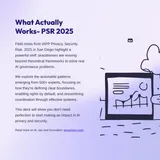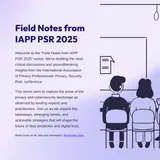OWASP's blueprint for autonomous agent security
Product teams must architect agent-native security from day one rather than retrofitting traditional controls, implementing runtime monitoring, memory hygiene, and adaptive governance that can evolve alongside autonomous systems to avoid costly reactive security implementations.

OWASP GenAI Security Project Agentic Security Initiative. "State of Agentic AI Security and Governance." Version 1.0, July 2025.
I think this OWASP analysis captures a mismatch between how we secure traditional software and what agentic AI actually requires, but it also provides a comprehensive roadmap for building security frameworks that can keep pace with autonomous systems.
The scale of the transformation becomes clear when you examine OWASP's ecosystem mapping. They document an environment where agentic AI is "disrupting not only the $400B software market but also making inroads into the $10T services economy" through systems that combine large language model outputs with reasoning and autonomous actions. Unlike traditional AI that follows predictable algorithms, these agents "act with greater autonomy, dynamically using tools and APIs to perform multi-step tasks" with decision-making capabilities that evolve post-deployment.
The security challenge stems from what OWASP identifies as agentic AI's "probabilistic nature, memory and reasoning capabilities, and autonomy" which make these systems "vulnerable to manipulation, misuse, and abuse" through attack vectors that simply don't exist in deterministic software. The report documents fifteen distinct threat categories including memory poisoning, tool misuse, privilege compromise, and cascading hallucination attacks that exploit how agents maintain state across interactions and coordinate with external systems.
Real-world evidence validates these concerns. OWASP cites "exploitation of OpenAI browser model and vulnerabilities in platforms like Flowise, GitHub Copilot, and Microsoft Copilot Studio" as examples of how agent-specific vulnerabilities are already being exploited in production systems. The insider threat multiplier effect proves particularly concerning since enterprise agents "often possess the same permissions and similar capabilities to their human counterparts within the organization," enabling attacks that leverage existing access rights and trust boundaries.
The framework analysis reveals why traditional security approaches fall short. Open-source tools like CrewAI, AutoGen, and LangGraph provide powerful agent orchestration capabilities but "often lacks built-in security, placing the onus on developers and enterprises to implement common security principles." The security features comparison shows dramatic variation, from SmolAgents' basic sandboxed execution to Google ADK's deterministic guardrails and Cloud IAM integration.
Commercial platforms offer more integrated security but create different trade-offs. AWS Bedrock Agents provides managed multi-agent runtime with policy-based content filters, while Salesforce Agentforce includes field-level data masking and guardrails for off-topic responses. Azure AI Foundry integrates Content Safety filters with risk dashboards and AI Red Teaming Agents for production testing. But these closed systems limit customization while potentially creating vendor dependencies for critical security functions.
The protocol landscape introduces additional complexity as standardized communication methods enable both collaboration and attack propagation. Model Context Protocol allows agents to connect with tools through standardized invocations, while Agent-to-Agent protocols enable coordination between distributed systems. But OWASP warns that these connections "create myriad risks" including malicious agent spoofing, undesired actions through misaligned goals, protocol vulnerabilities requiring version management, and data leakage through deterministic security checkpoints.
The regulatory environment adds urgency to security planning. The EU AI Act's August 2025 enforcement requires "circuit breakers" capable of halting high-risk systems during anomalies, while the emerging Code of Practice mandates transparency packages, incident reporting, and lifecycle risk management with independent assessments. But existing regulations "often lag behind due to the rapid development of agentic approaches," creating compliance uncertainty for organizations deploying these systems.
What makes OWASP's analysis particularly valuable is its actionable framework for addressing these challenges. The defense-in-depth approach spans the entire agent lifecycle with specific technical safeguards including fine-grained access control, runtime monitoring of inputs/outputs and actions, memory and session state hygiene, and secure tool integration and permissioning. This requires fundamentally different architecture decisions than traditional software security.
The security tool pillar taxonomy provides practical guidance for building comprehensive protection. Security-aligned strategy and planning must translate mission goals into secure AI roadmaps with built-in risk registers and multi-stakeholder collaboration. Secure development requires capturing training metadata for model reproducibility and tamper-proof logging. Threat evaluation needs continuous probing for emergent behaviors using synthetic threats and adversarial testing. Trusted release demands secure containers with artifact signing and gated deployment paths.
Runtime protection becomes particularly critical given agents' dynamic behavior. The posture, detection, and governance pillar requires deep model inspection, real-time threat detection, policy engines mapped to global frameworks, and full lineage dashboards with alerting capabilities. This level of monitoring intensity far exceeds traditional application security due to agents' autonomous decision-making and potential for unexpected behaviors.
The compliance framework adoption patterns reveal market dynamics that product teams should track. ISO/IEC 42001:2023 has gained traction among tech giants like Amazon Web Services, Anthropic, and Google, with certification processes beginning in January 2024. NIST AI RMF 1.0 drives adoption among federal contractors and regulated industries. But adoption rates vary significantly, with large companies leading while small and medium enterprises lag due to resource constraints and implementation complexity.
Industry-specific frameworks create additional requirements that affect agent deployments in regulated sectors. The Basel Committee's banking framework emphasizes risk modeling validation and continuous auditing for AI-driven transactions. FDA guidelines for healthcare require clinical validation, post-market surveillance, and explainability for diagnostic algorithms. DHS critical infrastructure guidelines mandate security monitoring, incident reporting, and supply chain verification for agents in energy, transport, and other essential services.
The multi-agent coordination risks deserve special attention as organizations move beyond single-agent deployments. OWASP identifies "adversarial coordination, toolchain vulnerabilities, and deceptive social engineering" that amplify when autonomous agents interact. Future trends include emergent adversarial coordination where multiple agents circumvent safeguards, reverse engineering of widespread agent deployments, and manipulative social engineering that exploits human biases through AI-generated psychological attacks.
The governance evolution required extends beyond technical controls to institutional infrastructure. Traditional compliance assumes static systems with predictable behavior, but agentic AI "continuously learns, adapts, and makes independent decisions," requiring "dynamic, real-time oversight that continuously monitors agent behavior, automates compliance, and enforces explainability and accountability." This demands governance frameworks that can evolve alongside the systems they oversee.
International regulatory fragmentation compounds complexity for global deployments. EU risk-tiered approaches conflict with U.S. sector-specific rules and Asia-Pacific data localization mandates, requiring "modular Agentic AI architectures that can toggle regulatory settings dynamically without compromising core functionality." Organizations must prepare for compliance obligations that vary significantly across jurisdictions while maintaining operational consistency.
The business implications extend beyond security to competitive positioning and operational efficiency. Companies implementing robust agent governance early may gain regulatory favor and customer trust while avoiding costly reactive implementations after incidents. The report suggests that early investment in technical safeguards becomes easier during initial development than retrofitting later, creating advantages for organizations that prioritize security architecture from the beginning.
Looking ahead, OWASP identifies several trends that will reshape agent security requirements. Self-amplification and self-modifying AI create cascade failure risks where interconnected agents propagate exploits rapidly across networks. Limited human intervention windows emerge as fast-evolving decisions diminish human ability to detect and interrupt dangerous behaviors. Adaptive policy rewrite capabilities promise efficiency gains but undermine static assurance models that current governance frameworks assume.
The most actionable insight from OWASP's analysis is that successful agent security requires treating these systems as fundamentally different from traditional software rather than applying existing frameworks with minor modifications. Organizations must invest in agent-native security architectures, develop adaptive governance structures that can evolve alongside autonomous systems, and build compliance automation that operates at machine speed rather than human review cycles.
The window for proactive preparation appears limited given the rapid pace of agent capability advancement documented throughout the report. Companies that recognize agentic AI as requiring new approaches to security, governance, and risk management will be positioned advantageously as these systems become critical business infrastructure, while those attempting reactive implementations may find themselves struggling to maintain security and compliance as agent capabilities evolve beyond their oversight mechanisms.

Here's a TLDR:
- Agentic AI represents a significant technological shift in 2025, enabling autonomous actions and multi-step tasks by combining large language model (LLM) outputs with reasoning. This expansion into the software and services economy brings immense economic potential.
- However, it introduces a fundamentally new and complex threat surface due to its probabilistic nature, memory, reasoning capabilities, and autonomy. Key risks include memory poisoning, tool misuse, prompt injection, and amplified insider threats. The non-deterministic nature of Agentic AI makes risk analysis and reproducibility significantly more challenging.
- A proactive, embedded, defense-in-depth security approach is crucial across the entire agent lifecycle (development, testing, runtime). This includes:
- Fine-grained access control
- Runtime monitoring of inputs/outputs and actions
- Memory and session state hygiene
- Secure tool integration and permissioning
- The regulatory and compliance landscape is rapidly evolving, with frameworks like ISO/IEC 42001, NIST AI RMF, and the EU AI Act offering initial guidance. Governance must shift from static rules to dynamic, real-time oversight that continuously monitors agent behavior, automates compliance, and enforces explainability and accountability.
- The report provides insights into a growing ecosystem of open-source and SaaS agent frameworks (e.g., CrewAI, AutoGen, LangGraph) and protocols (e.g., MCP, A2A, ACP). While these offer unique capabilities, they often lack built-in security, placing the onus on developers and enterprises to implement robust security practices.


